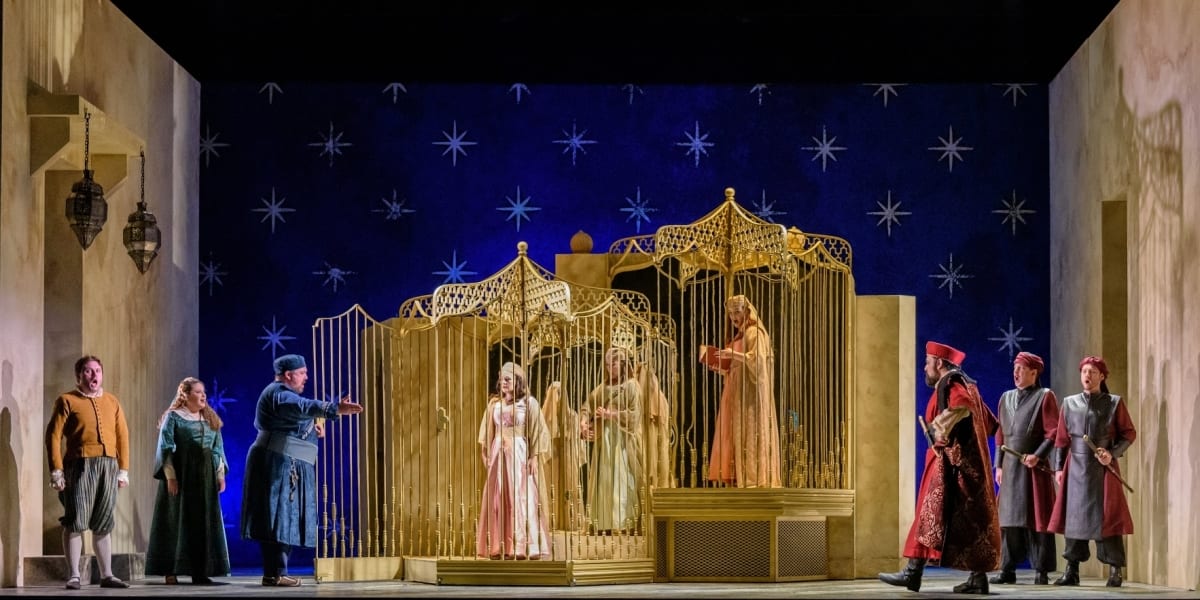Mozart was a businessman who was always on the lookout for ways to make money and get his music to a wider audience. This singspiel, written in 1782 for the new German Opera in Vienna, was his attempt to establish a reputation in the imperial city, having left Salzburg under a cloud. Though The Seraglio was part of a fashion for plays and operas about the exotic culture of the Middle East, Mozart transcended the clichés of the genre and produced his first masterpiece. This charming English Touring Opera production does the work full justice.
Belmonte is seeking his lover, Konstanze, who has been bought from the pirates who abducted her by Pasha Selim and installed in his harem. Also in the Pasha’s custody are Konstanze’s maid Blonde and Belmonte’s steward Pedrillo. The Pasha has fallen in love with Konstanze and wishes to gain her consent to their union, though he reminds her constantly that he could take her by force. Belmonte arrives and finds Pedrillo and they plot to rescue the women from the harem and to outwit the brutal Osmin, who oversees the Pasha’s household. The plot goes awry but the Pasha has a change of heart and all ends happily.
The musical power of any Seraglio depends a lot on the singers who play Konstanze and Belmonte. ETO’s reputation is such that they seem to be able to attract very fine young singers, even though two months of touring must be a real test of technique and stamina. John-Colyn Gyeantey is a fine Belmonte. His high tenor is light enough to cope delightfully with the music Mozart wrote for his arias of yearning and despair but he can also turn on the power when it is needed. Until the final act there is little opportunity for romantic duets and by this time Lucy Hall had established herself musically and dramatically as a woman to be reckoned with. She was a little unfocused in the early very demanding arias, which foreshadow the soprano pyrotechnics that Mozart eventually perfected in The Magic Flute. But by the final act she was totally in control of the almost tragic music she sings when she and her lover face death.
The comic power of the opera relies on how effective Osmin is as the brutal and lascivious overseer and how he handles his encounters with Pedrillo and Blonde. It is in his confrontations with Blonde, sung by the irrepressible Nazan Fikret, that this production really comes to life. The massage scene is a triumph and we almost feel sorry for Osmin by the end. Fikret has a powerful soprano voice but also a talent for comedy that is right to the fore here. Matthew Stiff’s enormous Osmin is the perfect foil for Blonde and, because of director Stephen Medcalf’s decision to make the women more than the usual maidens-in-distress, he seems a more substantial figure than the one we often see in the role. Richard Pinkstone seems equally in awe of Blonde but he makes the most of his opportunities to undermine Osmin and to set up the escape.
Mozart was always able to upset expectations for any genre he approached and he does so in the final scene of Seraglio where Muslim Pasha Selim (a non-singing role here taken by Alex Andreu) proves to have the Christian virtues so signally lacking in the Spanish family of Belmonte. Andreu invests the role with menace and dignity in equal measure – however often one sees the final scene, it still startles with its brave humanity.
The ETO orchestra responded with fire and ice to conductor John Andrews whose talent for bringing the best out of Mozart scores was fully evident here. The production is of necessity designed for travelling from town to town and the mirrored birdcage harem looked a little flimsy to me but the simple revolve that allowed for speedy scene changes and provided the contrast between Osmin’s workshop and Konstanze’s gilded prison worked well. The production can be seen at seven other locations over the next six weeks – it deserves full houses.

